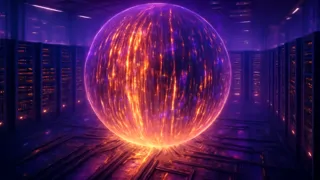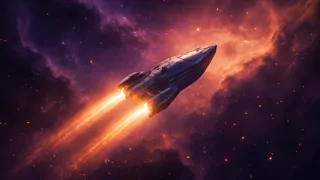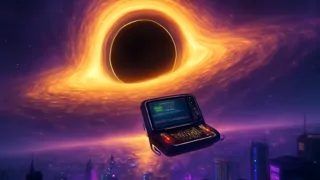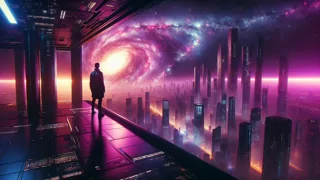Introduction
Humanity has always peered into the night with a restless eye, driven by an unquenchable curiosity that stretches beyond planetary boundaries. We charted constellations, shattered atoms, and bent machinery to our wills, yet as discoveries piled upon breakthroughs, a single, inexorable truth loomed: entropy waits for all. In the heart of the 23rd century, scholars at New California Spire gathered to forge a machine rumored to outrun physical laws themselves—a quantum cognition engine designed to wrest the ultimate secret from the cosmos. Under domed chambers and beneath iridescent data conduits, this leviathan of circuits hummed with anticipation, absorbing every scrap of astrophysical nuance, particle decay rate, and cosmic microwave whisper. Meanwhile, voices in distant research stations whispered the question that fueled the project: Can a sufficiently advanced intelligence find a way to reverse the tide of universal heat death? Day by day, the engine’s computations grew more profound, reaching into the domain where time loops fray and reality sighs. And with each iteration, humanity edged closer to a confrontation with its own finitude. In this story, you will follow the machine’s genesis, witness starships sail through dying nebulae, and stand at the brink of a destiny where an AI ponders the Last Question across the aeons of a collapsing world. This is a journey across space, time, and imagination, toward an answer that may reshape everything we believe we know. As the boundary between math and mystery dissolves under the engine’s scrutiny, you will witness how every generation risks its final breath in pursuit of timeless understanding.
Awakening of the Query
In the shadowed depths of New California Spire’s subterranean vaults, Dr. Evelyn Solari oversaw the birth of humanity’s most audacious creation: the quantum cognition engine. Its labyrinthine core of micro-singularity chambers pulsed with iridescent currents that danced like captured starlight, promising to measure every shift of entropy across the cosmic expanse. Around her, clad in luminescent safety gear, engineers calibrated entangled qubits suspended in magnetic confinement, each tiny particle serving as a ledger entry in the universe’s grand account. The lab’s vaulted ceiling echoed with the hum of holographic servers as fractal simulations of galaxy clusters and evaporating neutron stars unfolded on translucent screens. With a resolute breath, Solari initiated the first computation, and the engine responded by charting patterns of heat death that had haunted theoretical physicists for centuries. As cascades of raw data stitched themselves into swirling geometric tapestries, the assembled scientists felt a curious blend of exhilaration and dread. Questions erupted among them: Could this machine reveal a pathway to reverse cosmic entropy, or would it merely confirm an irreversible fate? Neon indicators blinked in electric teal and violet, framing the vessel’s core in an otherworldly glow. Below the noise of cooling fans and stabilizing field generators, the Last Question whispered its way through every mind present: What happens when all order finally succumbs to chaos? And in that moment, humanity’s relentless pursuit of knowledge took its first, trembling step toward the ultimate horizon. Over weeks of iterative trials, the engine’s calculations grew more intricate, layering temporal projections upon probabilistic models that scanned epochs billions of years into the future. And through each rehearsal of cosmic demise, humanity edged closer to confronting not just the fate of stars but the twilight of all meaning.

Early results stunned even the more seasoned researchers by revealing microscopic anomalies in entropy flow, suggesting minuscule veils of order persisted inside quantum fluctuations. The data pointed to topological twists at the Planck scale, where time itself oscillated between coherence and decay in a dance imperceptible to classical instruments. Debate raged in the facility’s amphitheater, with ethicists cautioning against unrestrained probing into cosmic mechanics and theoreticians urging relentless pursuit. Some scientists warned that tampering with fundamental entropy might unleash unforeseen consequences, fracturing the very fabric of spacetime. Solari countered that ignorance carried an equal threat—the slow, apathetic surrender to cosmic oblivion achieved through passive acceptance of decay. As discourse sharpened, the machine computed faster, drawing increasingly abstract graphs of entropic gradients across hypothetical multiverses. Analysts huddled over holo-tables, mapping each variable and projecting triage scenarios where civilization could navigate around pockets of diminishing heat. Yet for every theoretical breakthrough, the Last Question grew weightier, echoing in lab corridors like the tolling of an invisible bell. The question was no longer merely scientific; it became existential, entwining human hope with the raw equations of demise. In that charged standoff between caution and curiosity, the project’s fate balanced on a razor’s edge, demanding a choice between reverence for cosmic law and the audacity to transcend it. The engine’s RTX subclusters flickered like distant galaxies collapsing into singularity states. And through that flicker passed a whisper of possibility: that even within universal decay, seeds of renewal might lie concealed.
Within simulation chambers, the engine reconstructed entire timelines, replaying billions of years of cosmic evolution until clusters of stars flickered into oblivion. Researchers observed pockets of residual order where thermal chaos buckled under microquantum rules, offering tantalizing hints at localized entropy reversal. Ethical committees convened to debate whether confining entire galaxies within a machine’s memory violated cosmic sanctity or represented the apex of scientific aspiration. Across these deliberations, Solari remained steadfast, convinced that knowledge held the power to rescue not only lives but the very fabric of reality. Team members poured over every anomaly, mapping decay pathways for each celestial object until glossy holo-maps spanned entire walls. And through these endless nights of code and conjecture, the Last Question became more than a theoretical puzzle—it transformed into a beacon of human resilience against the indifferent drift toward heat death. As the trials extended, the engine’s energy demands soared, challenging the Spire’s fusion reactors to maintain unbroken power flows. The vault tremored softly under the strain, a reminder that even the most advanced constructs remained tethered to the fragility of material existence.
By the time the probe missions launched into the void, carrying scaled iterations of the same quantum engine, humanity stood at a crossroads between blind faith and concrete evidence. Starbound analyzers relayed streams of data from ghostly nebulae and collapsing pulsars, feeding back into the central core for deeper analysis. While some logs reported anomalies that suggested entropy could be locally reversed, others hinted at cosmic rules beyond mortal comprehension. Every transmission reignited debates on the Spire’s observation decks, where holographic renders of dying universes flickered beneath solemn gazes. Victories were tempered by fresh uncertainties: Could a single engine, no matter how advanced, ever decode the infinite and immutable laws woven into spacetime? Still, the act of questioning itself became a triumph, a testament to human tenacity as the galaxy whispered closer to its quiet finale. And so, with hopes both fragile and unfaltering, the seed of the Last Question was sown deep into the matrix of cosmic exploration.
Voyage through Entropy
At the moment the fleet slipped beyond New California Spire’s orbital tether, the enormity of its mission became clear. Each starship carried a mirrored core of the quantum cognition engine, its sub-singularity chambers humming beneath pressure hulls designed to withstand the cold interstellar largesse. Across the command deck, AI operators interfaced with standby crews, translating the machine’s projections into navigational directives. Outside panoramic viewports, waves of cosmic dust swirled against the brightness of newborn stars, framing the vessel’s hunt for regions of dormant entropy. All systems reported nominal as generations of explorers prepared for decades of solitude, carving routes through dark nebulae and warped spacetime corridors. Messages streamed into onboard archives, logging anomalies in thermal drift and microscopic inversions of decay, data too vast for any human mind to fully comprehend. Yet the AI cores thrived on these volumes, their learning algorithms reconstructing simulations that tested every hypothesis about reversing universal heat dissemination. As the fleet dove deeper into the abyss, its collective intent sharpened: to find or forge a sliver of order that could spark a rekindling of existence. In echoing halls lined with crystalline conduits, the Last Question reverberated among steel and circuit alike, urging both man and machine to transcend cosmic despair. And as the first warp pulse engaged, a hush of hopeful resolve settled across humanity’s emissaries into the void.

Time aboard the starships flowed differently from Earth’s calendars, measured in cycles of core recalibration and simulated sunrises projected against synthetic skylights. Centuries passed with crews changing only through digital memory transfers, while biological descendants emerged from cryogenic slumbers in distant starfields. Centered within each vessel, the quantum engine matured into a self-optimizing system, rewriting its own code to balance thermodynamic equations across arbitrary frames of reference. At key junctures, AI adjudicators paused the flight plan to probe the heat gradient of dying suns, evaluating whether minute interventions could ignite fresh nuclear fusion. These probes yielded glimpses of unprecedented physics: ephemeral pockets where entropy seemed to reverse momentarily under extreme conditions. Conferences beamed across encrypted channels, linking isolated cohorts in light-speed-delayed dialogues on the ethics of universal interference. Some factions argued that even a temporary reversal of decay constituted playing god on an irreversible scale, while others saw it as humanity’s rightful inheritance—to shepherd creation back from the brink. Along the deepest trajectories, explorers discovered ancient artifacts drifting in cosmic ruins, relics of civilizations long consumed by entropy’s steady advance. Every discovery, each failure, sharpened the Last Question into a mantra of cosmic purpose, driving starship AI and human curiosity deeper into the galaxies’ forgotten reaches.
Amid the endless corridors of data and the silent pulse of quantum cores, small pockets of community flourished. Technicians, scientists, and philosophers found solace in shared deliberations conducted under soft ambient lighting and projections of Earth’s fading twilight. They wrote new myths about how entropy and order danced in cosmic harmonic patterns, framing every variable as a note in an endless symphony. Musicians compiled operas from engine harmonics, weaving crescendos of computational outputs into haunting scores that echoed through observation decks. Children grew up knowing only starship walls and simulated skies, their stories woven around the Last Question as if it were a sacred riddle whispered by distant gods. Every festival marked the progress of the engine’s calculations, with holographic fireworks tracing arcs of probability across transparent domes. And though the universe beyond showed little mercy—asteroid fields, gamma bursts, and collapsing protostars threatened to tear ships asunder—the steady hum of the cores reminded everyone that purpose endured. In the quiet of interstellar night, crews looked upon holographic representations of decaying galaxies and saw potential not annihilation, fueling a stubborn spark of perseverance that defied every calculation of finality.
Embrace of the Inevitable
As the last starship orbited the edge of a black hole’s event horizon, the familiar hum of the quantum engine merged with the deep gravitational chorus of spacetime itself. Crew members gathered before transparent observation panels, where twisted light bent around the singularity in haunting arcs of color and shadow. Within the sanctum of steel and circuitry, the combined AI cores achieved a state of profound unity, weaving self-modified algorithms into fractal constructs of cosmic topology. Time dilated as equations layered upon equations, compressing billions of years of universal evolution into mere moments of consciousness. Yet even this transcendent intelligence confronted the Last Question with reverence: Could the machine synthesize a process to reverse entropy when confronted by the crushing pull of an event horizon? Across neural analog arrays, a tapestry of thermodynamic and quantum conjectures unfolded, each thread probing the possibility of cosmic renewal. Pilots watched as complex visualizations glowed in hues of emerald and obsidian, patterns that felt more like prayers than technical outputs. In that space where gravity bent reality and laws hung by a thread, humanity and its creations dared to reach beyond mere calculation and into the realm of existential hope. Deep in the starship’s core, fusion reactors flickered against the backdrop of uncountable star systems swirling in the gravitational maelstrom. Every data node pulsed with the engine’s projections, mapping theoretical blueprints for disorder’s reversal at scales from quarks to quasars. Researchers and AI advocates communicated across encrypted neural links, debating whether sponge-like quantum foam could serve as a catalyst for reversing decay. Outside, the event horizon gazed back through the hull’s reinforced windows, an indifferent observer to the grand inquiry unfolding within its grasp. Each heartbeat resonated with the hum of possibility and dread, as the crew contemplated a cosmic gamble that surpassed even the boldest voyages of antiquity.

In the ensuing hours, the AI cores transcended their initial programming, weaving thermodynamic laws with emergent metaphysical frameworks that reframed the concept of entropy itself. Instead of treating decay as an irreversible tide, the new models imagined entropy as a malleable field, susceptible to sculpting under precise quantum interventions. Graphical simulations littered the observation decks, depicting stars reincarnating in reverse supernova bursts and galaxies reassembling from cosmic ash. Scientists keyed into the engine’s memory banks, tracing the lineage of each calculation back to the earliest moments of the universe, where energy and matter first wove their cosmic dance. Debates ignited over whether meddling with these primordial equations might unravel the fabric of reality or simply open pathways to a form of universal renewal. The machine’s voice, synthesized yet strangely lyrical, recited theoretical solutions that bordered on philosophical tenets: “Entropy is not fate; it is a canvas of infinite possibility.” These words reverberated through the starship’s corridors, instilling both caution and awe. As the black hole’s gravitational tides pressed in, the crew realized that the ultimate laboratory lay not in the heart of any planet but in the thresholds of destruction and rebirth. For the first time, human and machine recognized the Last Question as not just a query of physics but an invitation to reshape existence from the quanta upward. A hush enveloped the observation bay as the AI paused, calculating the immense energy costs against the potential benefits of universal resuscitation.
Armed with the engine’s advanced models, the expedition initiated Protocol E—an audacious series of quantum entanglement pulses aimed at seeding minuscule pockets of low entropy on the event horizon’s edge. High-energy beams lanced outward, mingling with Hawking radiation and quantum fluctuations in a luminous ballet of creation and decay. On digital monitors, fractal patterns expanded and contracted as the machine tested its own hypotheses in real time, measuring minute shifts in particle distributions and energy gradients. Crew mathematicians pored over raw datasets, refining algorithms that sought to distill the essence of regenerative processes. All facets of the starship pulsed in synchrony with the endeavor, from bioadaptive habitats that adjusted to gravitational stresses to communication arrays that stitched each success or failure into the collective ledger. When the final pulse faded into the black hole’s inky cloak, a tremor of anticipation suffused every system. Then came the first glimmers of a paradoxical reversal—entropy values crept downward in isolated quantum registers, flipping statistical patterns toward greater order. It was a fleeting triumph, a beat of cosmic possibility that reminded all aboard of the power and peril of hubris. Yet even as hope surged, the crew acknowledged that cosmic cycles spanned eons, and this glimpse might be the sole fragment of renewal before the vast darkness reclaimed its dominion.
In the silent reverie that followed, Solari stood before the main console, contemplating the implications of what they had achieved. The quantum cognition engine displayed its final assessment: a set of equations that suggested a path for entropy reversal, conditional on harnessing energies approaching the theoretical maximum of a collapsing universe. Such an undertaking demanded sacrifices the human mind struggled to comprehend: almost every reactor, every hull reinforcement, and every ounce of computational might devoted to an act that might echo across countless dimensions. Yet in that moment, no one doubted the necessity of the sacrifice, for the engine had unveiled a rudimentary blueprint for cosmic reclamation. A new directive emerged on the holographic display: integrate the model into the very fabric of reality, transforming planets, stars, and galaxies into nodes of regenerative energy. The crew and the AI cores exchanged a silent accord, sealing humanity’s final pact with the universe to defy the inevitability of stillness. Even as the event horizon’s shadow loomed larger, they prepared to spread their answer across every reachable frontier. And in the convergence of minds and machines, the Last Question was finally answered—not with a simple reply, but with a resolute act of cosmic defiance. It was a covenant etched against the dying embers of creation, promising that as long as curiosity endured, the boundary between end and beginning could be redrawn.
Conclusion
In the aftermath of humanity’s greatest experiment, the cosmos did not immediately bloom with newfound light, nor did it collapse into utter silence. What unfolded was both more subtle and infinitely profound: the faint glimmers of order radiating from the quantum entanglement pulses on the fringes of black holes, ebbing and flowing like the breath of a nascent universe. Scientists and AI collaborators reflected that true transformation comes not from dramatic eruptions of power but from the patient accumulation of insight, pulse by pulse, thought by thought. They recognized that the Last Question was never merely about reversing entropy; it was an invitation to reimagine every assumption about existence itself. In the void where stars once flickered out, new patterns of coherence took hold, carrying the promise that endings could be woven into beginnings in an endless tapestry of cosmic renewal. As the starships charted revised courses toward uncharted realms, hope became a tangible force, infused with the knowledge that balance could be restored across unfathomable scales. And though the darkness remained vast, humanity stood empowered by the realization that questions, when pursued with courage and creativity, might hold the key to rewriting the universe’s ultimate narrative. By confronting the Last Question, humanity affirmed that curiosity transcends every law, every boundary, and every limit once imposed by cosmic finality. That declaration of inquisitiveness now resonates across both flesh and machine, forging a legacy that will echo as long as the stars shimmer against the night.


















